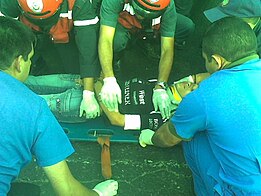Trauma system
| Advanced trauma life support | |
|---|---|
 |
|
| General information | |
| Names | Advanced trauma life support |
| Abbreviation | ATLS |
|
Fiel
|
Medicine |
| History | |
| Inventor | James K. Styner, Paul 'Skip' Collicott |
| Invention date | 1978 |
| Description | |
| Organizer | American College of Surgeons |
| Participants | emergency physicians, paramedics and other advanced practitioners |
| Duration | 3 days (for hybrid course) |
| Frequency | 1 week – 1 mounth |
| Additionally | |
|
Related courses
|
Advanced cardiac life support |
Advanced trauma life support (commonly abbreviated ATLS) is a training program for medical providers in the management of acute trauma cases, developed by the American College of Surgeons. Similar programs exist for immediate care providers such as paramedics. The program has been adopted worldwide in over 60 countries, sometimes under the name of Early Management of Severe Trauma, especially outside North America. Its goal is to teach a simplified and standardized approach to trauma patients. Originally designed for emergency situations where only one doctor and one nurse are present, ATLS is now widely accepted as the standard of care for initial assessment and treatment in trauma centers. The premise of the ATLS program is to treat the greatest threat to life first. It also advocates that the lack of a definitive diagnosis and a detailed history should not slow the application of indicated treatment for life-threatening injury, with the most time-critical interventions performed early. However, there is no high quality evidence to show that ATLS improves patient outcomes as it has not been studied.
The first and key part of the assessment of patients presenting with trauma is called the primary survey. During this time, life-threatening injuries are identified and simultaneously resuscitation is begun. A simple mnemonic, ABCDE, is used as a memory aid for the order in which problems should be addressed.
The first stage of the primary survey is to assess the airway. If the patient is able to talk, the airway is likely to be clear. If the patient is unconscious, he/she may not be able to maintain his/her own airway. The airway can be opened using a chin lift or jaw thrust. Airway adjuncts may be required. If the airway is blocked (e.g., by blood or vomit), the fluid must be cleaned out of the patient's mouth by the help of suctioning instruments. In case of obstruction, pass an endotracheal tube.
The chest must be examined by inspection, palpation, percussion and auscultation. Subcutaneous emphysema and tracheal deviation must be identified if present. The aim is to identify and manage six life-threatening thoracic conditions as Airway Obstruction, Tension Pneumothorax, Massive Haemothorax, Open Pneumothorax, Flail chest segment with Pulmonary Contusion and Cardiac Tamponade. Flail chest, tracheal deviation, penetrating injuries and bruising can be recognized by inspection. Subcutaneous emphysema can be recognized by palpation. Tension Pneumothorax and Haemothorax can be recognized by percussion and auscultation.
...
Wikipedia
